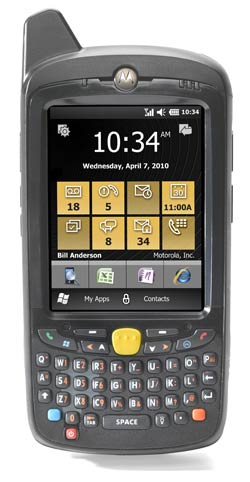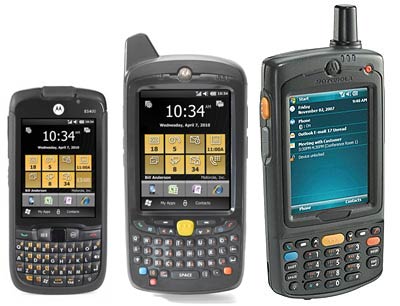|
Motorola MC65
A faster, tougher new version of Moto's mid-range "Enterprise digital assistant" with new features
(by Conrad H. Blickenstorfer)
Motorola is increasingly serious about offering a full line of commercial and industrial quality "Enterprise Digital Assistants," or "EDAs." EDAs are supposed small, yet tough and durable device that serves different workers in different environments in a variety of functions.  On March 21, 2010, Motorola introduced the MC65 EDA, a complement and eventual successor to the company's MC55. The MC65 combines the functionality of a cell phone, a bar code scanner, a camera, a walkie talkie and a mobile computer all into one small and handy device. And it's faster, tougher and more advanced than the MC55. On March 21, 2010, Motorola introduced the MC65 EDA, a complement and eventual successor to the company's MC55. The MC65 combines the functionality of a cell phone, a bar code scanner, a camera, a walkie talkie and a mobile computer all into one small and handy device. And it's faster, tougher and more advanced than the MC55.
The MC65 is a significant technology update to the midrange of a line of ruggedized PDAs that started when Motorola's Symbol Technologies first had the foresight to offer an industrial, scanner-equipped version of the then enormously popular Palm III in 1998 or so. From that emerged a class of small enterprise handheld computers geared towards communications and data capture requirements of mobile workers that grew into today's lineup of Motorola Enterprise Digital Assistants. They currently include the small and recently introduced ES400, the MC55, the new MC65 that seems to replace it, and the top-of-the-line MC75:

Above: Motorola's Enterprise Digital Assistants ES400, MC65, and MC75
In this lineup, the new MC65 is for workers who need something more rugged than the small ES400 with its 3-inch display but somewhat less costly than the no-holds-barred MC75A.
In terms of looks and design, the MC65 is almost indistinguishable from the MC55, but looks deceive as the MC65 is faster, tougher, better sealed and has more features. And that's on top of the usual tech updates common in this fast-paced world of handheld electronics.
So let's take a look at what all the new MC65 offers:
While most unsers will never notice anything other than its faster operation compared to the MC55, it's interesting that Motorola switched from a Marvell PXA processor to a 600MHz MSM Qualcomm 7627 CPU. This is an ARM11 processor supporting the ARMv6 instruction set and has been used in such handhelds as the Palm Pixi, a variety of other smartphones, and, most notably, in Moto's own recently released ES400. So that's a move away from Marvell.
The HC65 runs Windows Mobile 6.5 Professional with a customizable user interface courtesy of MEUI, Motorola's Enterprise User Interface that's supposed to provide quicker and easier access to features and apps and lets users tailor the device to their workflow. Onboard RAM has doubled to 256MB, and onboard Flash quadrupled to 1GB compared to the MC55, and there's an micro-SD Card slot that supports cards up to 32GB. There's integrated 802.11a/b/g WiFi and Class II Bluetooth as before, but the MC65's integrated camera sports higher 3.2-megapixel resolution.
In terms of size and weight, the MC65 is a tiny bit larger in most dimensions but still only measures about 6.5 x 3.1 inches and is just 1.3 inches thick. Weight is about 12.5 ounces. That means that the MC65 is quite a bit larger and heavier than standard consumer smartphones, but it still fits into most pockets. The touchscreen display measures a generous 3.5 inches diagonally and has an LED backlight. Most importantly, it offers full 480 x 640 VGA resolution, which means four times the pixels of the QVGA MC55 display.
In terms of ruggedness, even the existing MC55 was far tougher than any commercial market PDA, and the new MC65 is significantly tougher yet. It can handle 6-foot drops instead of four, is sealed to IP65 specifications instead of the MC55's IP54. In IP65 sealing, the "6" means the device completely sealed against any dust intrusion, and the "5" that it is protected against low pressure water jets from all directions. The operating temperature range is a wide 14 to 122 degrees Fahrenheit. Motorola also quotes a "tumble spec" where the devices survive 2000 1.6 foot tumbles, far more than the already tough MC55.
Big changes on the communications side: Instead of being limited to just 2.5G GSM/GPRS/EDGE as the MC55 is, the new MC65 offers a Motorola first, the ability to connect to virtually any wireless carrier around the world via integrated dual 3.5G GSM HSPA and CDMA Rev A software-confgurable cellular radios! The MC65 also supports autonomous and assisted GPS with Moto's gpsOneXTRA.
As pretty much all Moto devices, the MC65 is well equipped for data capture. However, things got simpler and users no longer have to decide between four different configurations as was the case with the MC55. That's because the MC65 comes with the powerful Symbol SE4500 imager (the MC55 used the SE4400) that can handle any 1D and 2D barcode and decoding task. So now customers just need to decide if they want a device with just the SE4500 imager, or one that includes the 3.2mp auto-focus camera with its user-controllable flash as well. An optional snap-on magnetic card reader is available.
For power, the MC65 comes standard with the 3.7V/3,600mAH Li-Ion battery that was only available as an "extended" option on the MC55. Motorola lists a talk time of six hours and 100 hours standby for this now standard battery.
As was the case with the MC55, the MC65 is meant to fill the gap between consumer PDAs and industrial devices, only with even more emphasis on toughness and performance. As such, the MC55 is a cross-over product that's both handy and rugged, serves as an advanced data capture device, offers robust voice and data communication, and now even frees users from being limited to whatever cellular provider is in their area.
|



